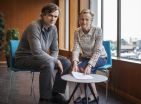(Press-News.org) A study of marine mammals and other protected species finds that several once endangered species, including the iconic humpback whale, the northern elephant seal and green sea turtles, have recovered and are repopulating their former ranges.
The research, published in the June edition of Trends in Ecology and Evolution, suggests that some species, including humpback whales, have reached population levels that may warrant removal from endangered species lists.
But returning species, which defy global patterns of biodiversity loss, create an urgent new challenge for policymakers and communities, the study suggests. While many people embrace the environmental and economic benefits of returning species - many of them large predators - others interpret the animals' recovery as a hostile invasion, encroaching on key fishing and recreation areas, researchers say.
"Most people support the idea of saving endangered species," says lead author Joe Roman of the University of Vermont's Gund Institute for Ecological Economics. "But when native species return, it can be a struggle for communities. After generations away, these forgotten species can suddenly be seen as newcomers - or even pests."
The return of North Atlantic gray seals has been blamed in Massachusetts for declining fishery yields and attracting sharks to Cape Cod. Some fishermen in Alaska and Washington State blame returning whales for reducing black cod and salmon stocks. In California, harbor seal pupping has resulted in temporary closures of public beaches.
"The takeaways here are that conservation clearly can work, which is important to celebrate given the trend of declining global biodiversity," says Roman, who is also a professor at UVM's Rubenstein School of Environment and Natural Resources. "But wildlife managers need to do a better job of planning for the return of these species to avoid future conflicts."
Researchers make four recommendations, including: planning ahead for impacts and adaption with stakeholders; delisting species that no longer require protection to shift efforts to other species; improving policy decisions for "nuisance animal" killings by assessing the total costs and benefits - economically, environmentally and culturally - of returning species; and celebrating conservation successes with the public.
A recent analysis of 92 marine mammal populations by another team found that 42 per cent were increasing, the researchers add.
BACKGROUND
The study was conducted by four U.S. marine biologists, including lead author Joe Roman (University of Vermont) and co-authors Meagan Dunphy-Daly, David Johnston and Andrew Read (Duke University).
For the study, researchers looked at population data for marine mammals and other protected species. Of the 87 cetacean species (whales, dolphins and porpoises) examined, 22 are recovering, 15 are endangered, and 45 cannot be evaluated due to data limitations. Twenty-six species of pinnipeds (seals, sea lions, and walruses) are secure, and 13 are endangered.
Great whales represent a major conservation success, researchers say. Of the 14 species, four have seen dramatically recoveries, three are stable, and seven cannot be fully analyzed due to data availability. Ten of 14 populations of humpback whales could be removed from the U.S. endangered species list this July. This coastal species, popular among whale watchers, was recently seen off the coast of New York City for the first time in generations.
Researchers attribute the recovery of these species to global conservation efforts, especially national and international wildlife protection acts, such as the Convention on Trade in Endangered Species and the U.S. Endangered Species Act, which have reduced commercial hunting, protect habitats, control invasive species, and guide reintroduction efforts.
SOME SUCCESS STORIES
The report highlights success stories involving marine species, plus several notable recoveries of land mammals and birds. Examples include:
North Pacific Humpback Whale:
After being reduced by commercial exploitation to fewer than 1,500 individuals in the 1970s, these whales have increased by about 6 percent per year and now number 21,000 whales. This increase is roughly 14 fold in less than 50 years.
Australian Humpback Whale:
By the 1960s Australia's two populations of humpback whales dropped to fewer than 800 individuals. They have increased at or above 10 percent annually since the cessation of commercial whaling, and their population is now estimated at more than 40,000.
Northern Elephant Seal:
Reduced to as few as 20 individuals through overexploitation in the late nineteenth century, these seals are now approaching their carrying capacity of more than 200,000 seals in the North Pacific.
Sea Otter:
After more than 100 years of commercial exploitation, the North Pacific sea otter was reduced to about 1,000 individuals in 13 groups during the nineteenth century. After protections from hunting and reintroduction efforts from Alaska to Oregon, their population is now more than 107,000.
The American alligator, bald eagle, brown pelican, gray whale, and more than 20 other species have recovered and been removed from the U.S. list of Endangered and Threatened Wildlife. These examples show that conservation efforts can lead to recovery of species and ecosystems, researchers say.
LIFTING BASELINES
Fisheries scientists used the term "shifting baselines" to mark generational declines in species and stocks. The study authors say the conservation successes outlined above are important examples of "lifting baselines."
While these findings highlight several important conservation successes, the researchers note that more species are declining worldwide than growing. Large predatory fish have declined by two-thirds in the past century, and at least three species of marine mammals have gone extinct since the 1950s.
INFORMATION:
Researchers at Tohoku University and the National Institute of Information and Communications Technology (NICT) in Japan, have developed
a novel ultra-compact heterogeneous wavelength tunable laser diode. The heterogeneous laser diode was realized through a combination
of silicon photonics and quantum-dot (QD) technology, and demonstrates a wide-range tuning-operation.
The researchers presented their work at a Conference on Lasers and Electro-Optics (CLEO) in San Jose, California, on May 13. The related
paper was also be published in Applied Physics Express ...
A research group at Tohoku University has succeeded in fabricating an atomically thin, high-temperature superconductor film with a superconducting transition temperature (Tc) of up to 60 K (-213°C). The team, led by Prof. Takashi Takahashi (WPI-AIMR) and Asst. Prof. Kosuke Nakayama (Dept. of Physics), also established the method to control/tune the Tc.
This finding not only provides an ideal platform for investigating the mechanism of superconductivity in the two-dimensional system, but also paves the way for the development of next-generation nano-scale superconducting ...
An international team led by Thayne Currie of the Subaru Telescope and using the Gemini South telescope, has discovered a young planetary system that shares remarkable similarities to our own early solar system. Their images reveal a ring-like disk of debris surrounding a Sun-like star, in a birth environment similar to the Sun's. The disk appears to be sculpted by at least one unseen solar system-like planet, is roughly the same size as our solar system's Edgeworth-Kuiper Belt (commonly called the Kuiper Belt), and may contain dust and icy particles. This work provides ...
Using a brand new survey method, researchers in Bergen have asked a broad spectrum of people in Norway about their thoughts on climate change. The answers are quite surprising.
Some 2,000 Norwegians have been asked about what they think when they hear or read the words "climate change". There were no pre-set answers or "choose the statement that best describes your view" options. Instead the respondents had to formulate their views on climate change in their own words. The answers have provided striking new insight into what the average person on the street in Norway ...
Long-term changes in immune function caused by childhood trauma could explain increased vulnerability to a range of health problems in later life, according to new research by the Institute of Psychiatry, Psychology & Neuroscience (IoPPN) at King's College London and the NIHR Maudsley BRC.
The study, published today in Molecular Psychiatry, found heightened inflammation across three blood biomarkers in adults who had been victims of childhood trauma. High levels of inflammation can lead to serious and potentially life-threatening conditions such as type-2 diabetes, cardiovascular ...
Treatment options for chronic hepatitis C, a serious and life-threatening infection, have improved substantially and several new regimens with shorter durations and improved efficacy and safety profiles are now available.
Groups have raised concerns about the evidence used to support the approval of some newer drugs, however, and the issue has been used to cast doubt on their efficacy and even to question treatment or deny reimbursement.
To address these concerns, the US Food and Drug Administration's Division of Antiviral Products in the Center for Drug Evaluation ...
This news release is available in French. Montreal, June 2 -- A new study published by the team of Naguib Mechawar, Ph.D., a researcher with the McGill Group for Suicide Studies (MGSS) of the Douglas Institute (CIUSSS de l'Ouest-de-l'Ile de Montreal) and associate professor in the Department of Psychiatry at McGill University, sheds new light on the disruption of astrocytes in depression. Astrocytes, a class of non-neuronal cells, have previously been implicated in depression and suicide.
However, it was not known whether these cells were affected throughout the brain ...
Los Angeles, CA (June 2, 2015) Neighborhoods with more interpersonal conflict, such as domestic violence and landlord/tenet disputes, see more serious crime according to a new study out today in Journal of Research in Crime and Delinquency (JRCD). Private conflict was a better predictor of neighborhood deterioration than public disorder, such as vandalism, suggesting the important role that individuals play in community safety.
"Private conflicts, for example, domestic violence or friendship disputes over money or girlfriends, can and do spill over into public spaces, ...
Scientists from the University of Louvain have discovered that a key element of infant brain development occurs years earlier than previously thought.
The way we perceive faces -- using the right hemisphere of the brain -- is unique and sets us apart from non-human primates. It was thought that this ability develops as we learn to read, but a new study published in the journal eLife shows that in babies as young as four months it is already highly evolved.
"Just as language is impaired following damage to the brain's left hemisphere, damage to the right hemisphere ...
Children as young as 4 years old may reap better health from altruistic giving, a behavior that tends to be less common among kids from high-income families, according to new research on the nature and nurture of altruism published in Psychological Science, a journal of the Association for Psychological Science.
"The findings provide us with a new understanding of how children's altruistic behaviors, family wealth, and physiological health are intertwined," says psychological scientist and lead researcher Jonas Miller of the University of California Davis.
Previous ...





